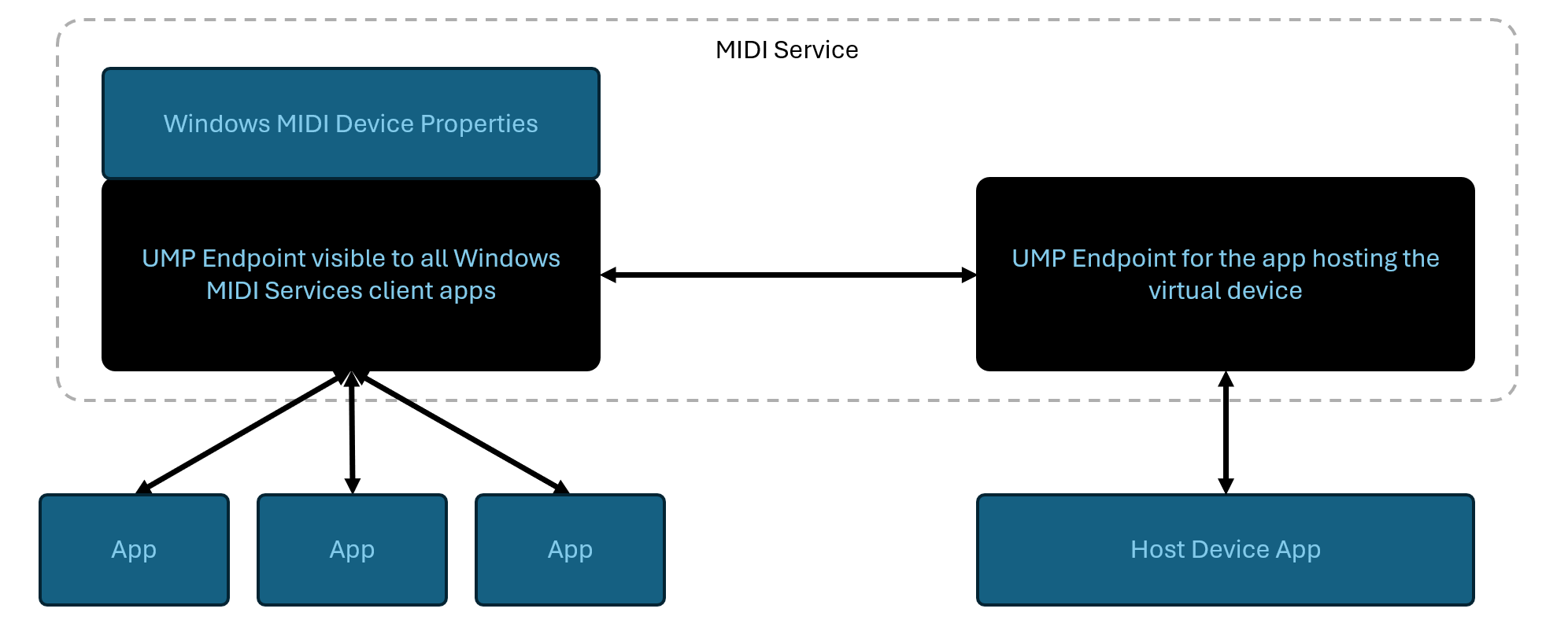Virtual Device App
| Property | Value |
|---|---|
| Transport Id | {8FEAAD91-70E1-4A19-997A-377720A719C1} |
| Abbreviation | APP |
Overview
One way to have app-to-app MIDI on Windows is to use a simple loopback. That is typically created ahead of time, and is available for any applications to use to communicate with each other. The lifetime of these loopback endpoints are not tied to any one application. They are simply a pipe between applications with no additional features or functionality.
Another approach is to allow applications to create and publish an endpoint which is declared through settings inside the application itself. When the application closes, the endpoint closes. That is the model the Virtual Device App feature implements. (If you want the simple pre-created loopback, see the Virtual Loopback transport)
In addition, MIDI 2.0 has additional requirements for endpoints. They need to be able to participate in the MIDI Endpoint Discovery process, and respond with appropriate endpoint capabilities, function blocks, and preferred settings. The Virtual Device App makes that configuration simple for application developers and musicians without having to handle individual discovery and protocol negotiation messages.

Lifetime
- The Virtual UMP Device includes two endpoints: one is just for the application creating the device (the “device side”), the other is for all other applications to connect to.
- The lifetime of the Virtual Device is controlled by the lifetime of the application’s connection. Once the owning application disconnects from the endpoint, the Virtual UMP Device is torn down.
Suggested Uses
This is the right kind of endpoint to create if you have an application which operates as a synthesizer, tone generator, or an input device, and you want the app to act and be seen in the same way a piece of MIDI hardware would be seen.
Today, the API provides support for MIDI 2.0 / UMP protocol. In the future, we’ll add MIDI CI and other capabilities to these virtual devices (today, those need to be done manually or through a third-party library).
Compatibility
The best experience for Windows MIDI Services will be with applications using the new Windows MIDI Services SDK. Only apps using the new SDK, and which are MIDI 2.0-aware, will be able to define and host Virtual Devices.
| API | Compatible App User | Compatible App Host | Notes |
|---|---|---|---|
| Windows MIDI Services Native | Yes | Yes | This provides the best experience for applications. |
| WinRT MIDI 1.0 | Yes | No | Any applications using the WinRT MIDI 1.0 API we shipped with Windows 10/11 will be able to see these devices and connect to them. Note that they can only send/receive MIDI 1.0 messages, and will not see any MIDI 2.0-specific messages that cannot be translated, including stream messages. |
| WinMM MIDI 1.0 | Yes | No | There are challenges around port numbers with dynamically-created endpoints like this, but the ports are optionally available to MIDI 1.0 ports. |
Configuration
Virtual Devices cannot be specified in the configuration file. Instead, applications must create them through code.
For developer information on how to set up a Virtual Device, see the developer how-to.